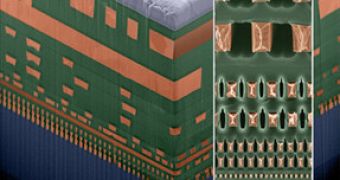After designing some next-generation 3D chips, we see IBM experimenting with all sorts of materials in order to build more efficient and faster electronic components. As part of this experiment spree, IBM gets inspired by nature's wonders and plans on building chips with the aid of natural pattern-creating processes that form seashells, snowflakes and tooth enamel. This way, IBM claims that the next generation of electronic chips will form trillions of holes to create vacuums as insulation around the miles of nano-scale wires packed next to each other inside the chip.
The technology through which electronic chips are made nowadays is quite obsolete, requiring the integration of copper wiring surrounded by an insulator. This also implies the use of a mask to create circuit patterns by beaming light through the mask and later chemically removing the parts that prove unnecessary. IBM scientists discovered that the masking and light-etching processes can be skipped altogether, using a vacuum gap as an insulator instead. With the right mix of compounds poured onto a silicon wafer traced by wired chip patterns, IBM claims that they have found a way to make self-assembling chips.
The major difference between the natural vacuum gap process and the one IBM is trying to emulate is that the "Big Blue" has been able to direct the self-assembly process to form similar trillions of holes, while the processes that occur in nature are all unique. The controlled process creates trillions of uniform, nano-scale holes across the surface of a 300 millimeter wafer. These holes are 20 nanometers in diameter on average, and IBM claims that these dimensions are up to five times smaller than those achieved with the help of today's most advanced lithography technique.
IBM is ready to use this technology in server product lines as well as for chips distributed to other companies, for example the Cell Broadband Engine found in the PlayStation 3 and various other server-related systems.

 14 DAY TRIAL //
14 DAY TRIAL //